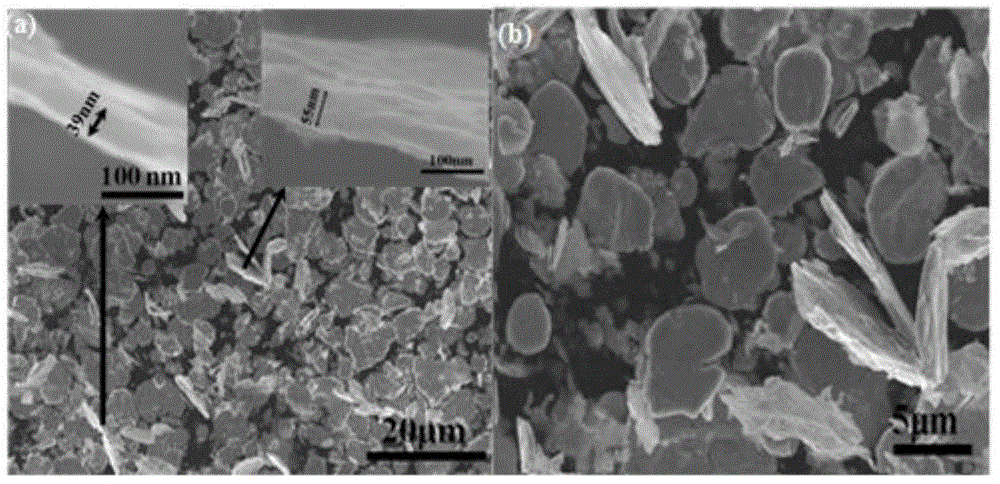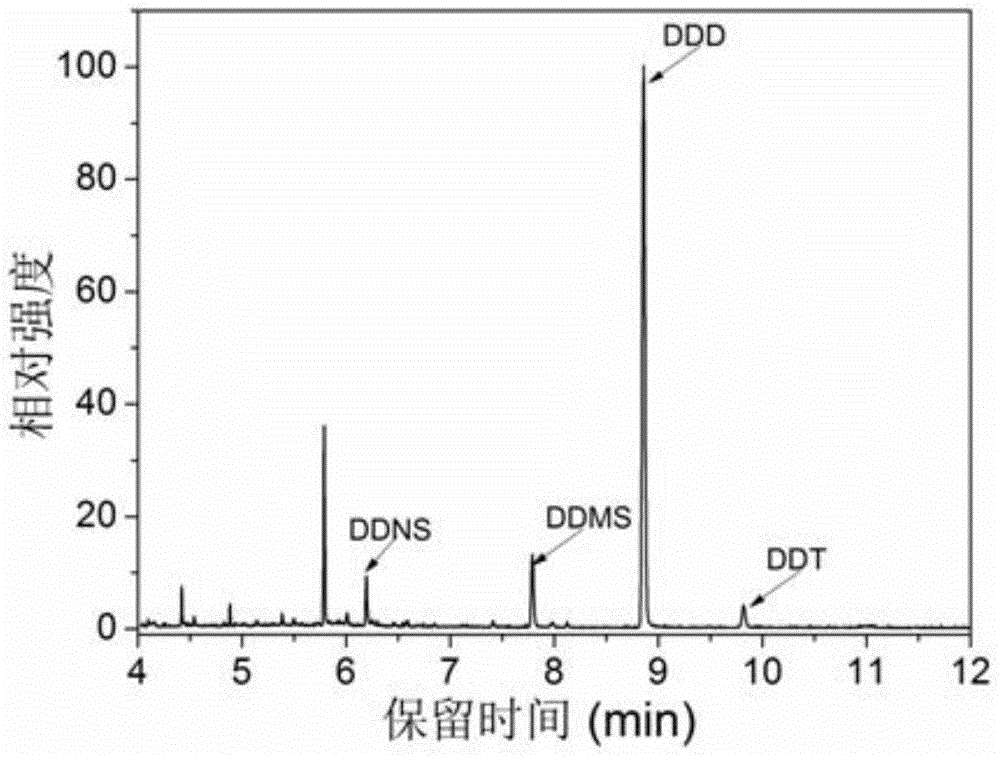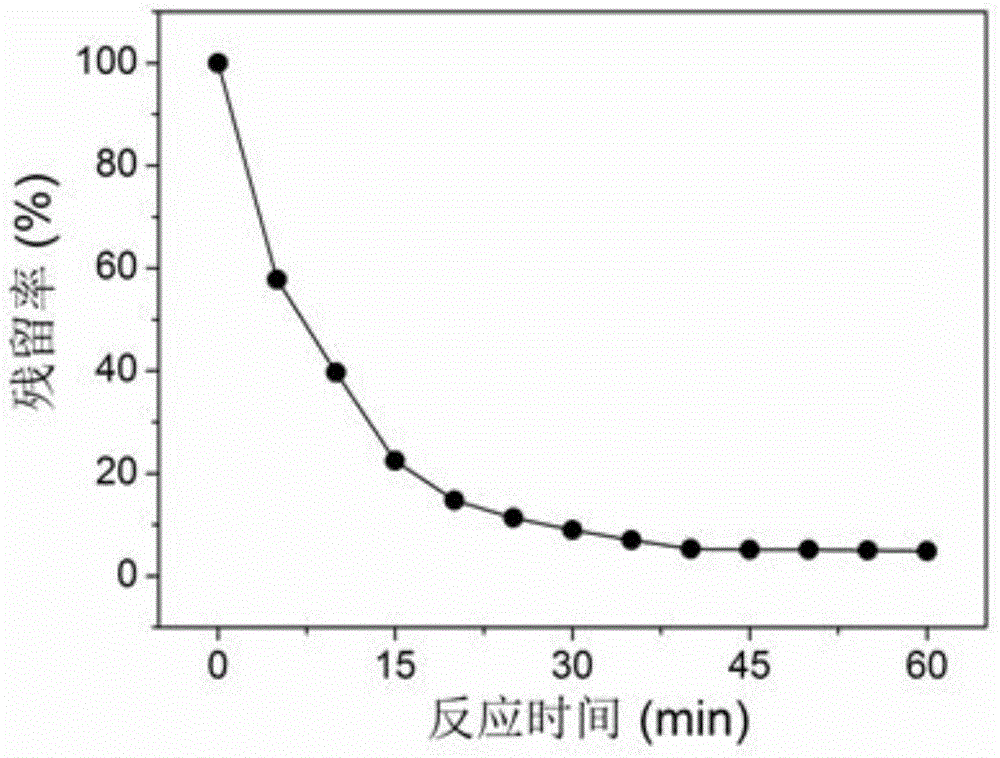Method for rapidly degrading DDT through acid-assisted flaky micro/nanostructure zero-valent iron
A rapid degradation and nanostructure technology, applied in the field of chemical applications, can solve long-term problems ranging from a few days or even a few months, and achieve the effect of low cost and shortened treatment time
- Summary
- Abstract
- Description
- Claims
- Application Information
AI Technical Summary
Problems solved by technology
Method used
Image
Examples
Embodiment 1
[0031] Example 1 A method for rapid degradation of DDT by acid-assisted flaky micro / nano-structured zero-valent iron, comprising the following steps:
[0032] (1) Take 12 20ml sample bottles, the bottle cap gasket is made of polytetrafluoroethylene, and add 40mg of flaky micro / nano-structured zero-valent iron to each sample bottle;
[0033] (2) Add 10ml of 5ppm DDT aqueous solution to each sample;
[0034] (3) Shake and vortex for 1 min to fully mix the sheet-like micro / nano-structured zero-valent iron with the solution;
[0035] (4) Add 100uL 1M HCl to each vial;
[0036] (5) Fill the vial to 25 o C on a constant temperature shaker, shake at 300 Hz for 5 min and take it out;
[0037] (6) Repeat (4) and (5), and end the whole reaction after 60 min;
[0038] (7) Add 5 ml of chromatographic grade n-hexane to the reacted sample, and vortex for 2 min;
[0039] (8) After standing and stratifying, take the supernatant for testing. The concentration change of DDT was analyzed b...
Embodiment 2
[0040] Example 2 A method for rapidly degrading DDT by acid-assisted flaky micro / nano-structured zero-valent iron, comprising the following steps:
[0041] (1) Take 12 20ml sample bottles and PTFE bottle pads, and add 40mg of flaky micro / nano-structured zero-valent iron to each sample bottle;
[0042] (2) Add 10ml of 5ppm DDT aqueous solution to each sample;
[0043] (3) Vortex and vortex for 1 min to fully mix the micro / nano-structured zero-valent iron with the solution;
[0044] (4) Add 50uL 1M HCl to each vial;
[0045] (5) Fill the vial to 25 o C on a constant temperature shaker, shake at 300 Hz for 5 min and take it out;
[0046] (6) Repeat (4) and (5), and end the whole reaction after 120 min;
[0047] (7) Add 5 ml of chromatographic grade n-hexane to the reacted sample, and vortex for 2 min;
[0048] (8) After standing and stratifying, take the supernatant for testing. The concentration change of DDT was analyzed by GC-MS as Figure 5 shown.
Embodiment 3
[0050] A method for rapid degradation of DDT by acid-assisted flaky micro / nano-structured zero-valent iron, comprising the following steps:
[0051] (1) Take 12 20ml sample bottles and PTFE bottle pads, and add 40mg of flaky micro / nano-structured zero-valent iron to each sample bottle;
[0052] (2) Add 10ml of 5ppm DDT aqueous solution to each sample;
[0053] (3) Vortex and vortex for 1 min to fully mix the micro / nano-structured zero-valent iron with the solution;
[0054] (4) Add 0 uL of 1M HCl to each vial;
[0055] (5) Fill the vial to 25 o C on a constant temperature shaker, shake at 300 Hz for 5 min and take it out;
[0056] (6) Repeat (4) and (5), and end the whole reaction after 60 min;
[0057] (7) Add 5 ml of chromatographic grade n-hexane to the reacted sample, and vortex for 2 min;
[0058] (8) After standing for stratification, take the supernatant for testing. The concentration change of DDT was analyzed by GC-MS as Figure 6 shown.
PUM
| Property | Measurement | Unit |
|---|---|---|
| diameter | aaaaa | aaaaa |
| thickness | aaaaa | aaaaa |
Abstract
Description
Claims
Application Information
 Login to View More
Login to View More - R&D
- Intellectual Property
- Life Sciences
- Materials
- Tech Scout
- Unparalleled Data Quality
- Higher Quality Content
- 60% Fewer Hallucinations
Browse by: Latest US Patents, China's latest patents, Technical Efficacy Thesaurus, Application Domain, Technology Topic, Popular Technical Reports.
© 2025 PatSnap. All rights reserved.Legal|Privacy policy|Modern Slavery Act Transparency Statement|Sitemap|About US| Contact US: help@patsnap.com



